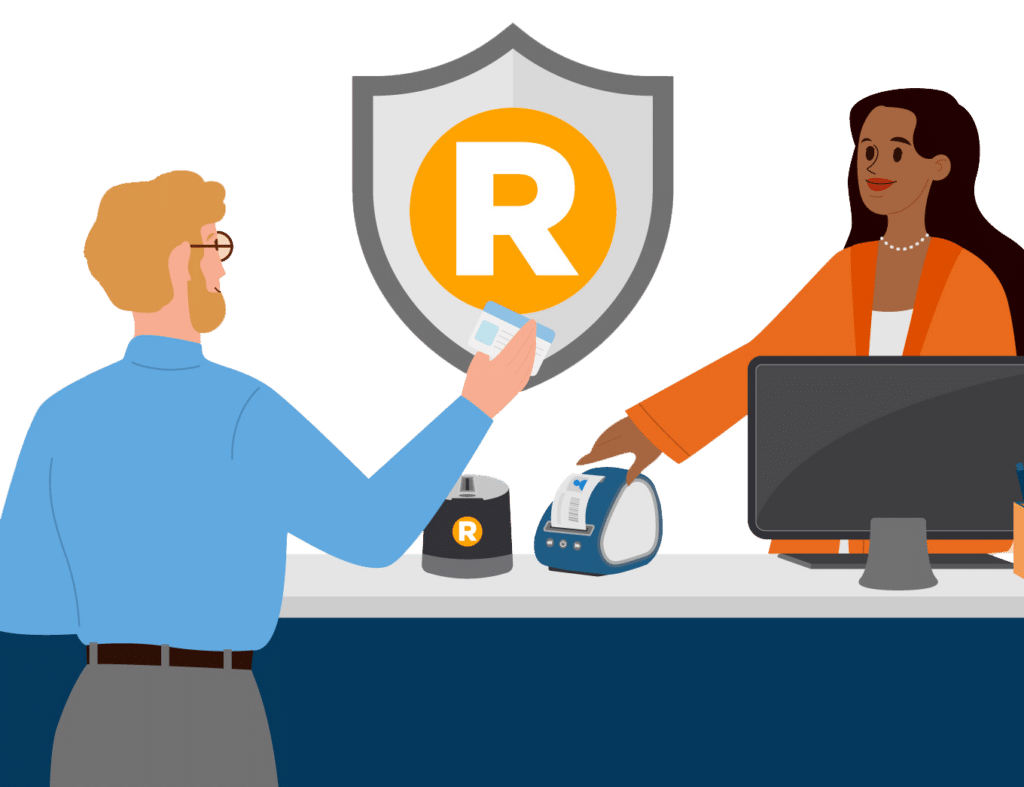Protect Your Community Organization
Community centers face unique challenges when it comes to approving and tracking guests and volunteers. There could be hundreds of visitors and volunteers entering the center each week and they all have various reasons for being there. Whatever the reason and whoever they are, you must confirm they are not a threat to your center or anyone in your buildings.

Overview of Visitor and Volunteer Management for Community Centers
Visitor‑management systems help you decide—within seconds—whether someone should enter your buildings:
- Instant ID Screening: Compare data from a government‑issued ID against sex‑offender registries in all U.S. states and territories.
- Custom Banned‑List Checks: Screen every visitor against custom lists of individuals barred or restricted from entry.
- Real‑Time Admit / Deny Decisions: Receive clear, immediate guidance on whether to grant access.
Volunteers are the lifeblood of community centers, yet manual approval processes slow everyone down. An automated volunteer‑management system can:
- Eliminate handwritten forms and spreadsheets.
- Shorten approval time with online applications, integrated background checks, and monthly monitoring.
- Streamline event creation, recruitment, scheduling, and hour tracking.
- Enhance safety by automatically screening volunteers for sex‑offender status and criminal history.
1. How to Create a Visitor and Volunteer Approval Policy
- Collect the right information first. Robust systems create “persona” types—visitors, guardians, contractors, and volunteers—to tailor screening rules.
- Screen every non‑member and non‑staff entrant. Include guardians, guests, contractors, and volunteers.
- Regularly re‑screen volunteers. Confirm volunteers continue to meet safety requirements with monthly monitoring of sex offender status and criminal background checks.
- Track purpose and location. Know who is in the buildings and why at any moment. This helps keep track of who is in the buildings and why. You’ll also have to decide who to screen.
FEATURED RESOURCE
This 3-part case study focuses on three YMCAs:
- Treasure Valley Family YMCA in Idaho
- Gateway Region YMCA in Missouri
- YMCA of Greater Brandywine Valley in Pennsylvania
Every community center needs a volunteer program that details how you will recruit volunteers and manage applications and background checks. You also need to stay in compliance with state laws, confirm each volunteer is approved to be in your buildings, create and schedule events, and report on all activity.
These tasks can be extremely time-consuming, especially when done manually.
- Publish a clear, web‑based application that gathers all required data.
- Automate criminal‑background checks and flag any disqualifying records.
- Define approval workflows, event scheduling, and hour reporting inside the same system.
- Align with state laws and organizational guidelines to keep volunteers—and those they serve—safe.
FEATURED RESOURCE
Volunteer Management Video
Watch on-demand as Debra Blossom, Volunteer Services Department Manager at Hillsborough County Public Schools (FL), Kyle Garner, Director of Strategic Alliances at JDP (background checks), and Arsalan Mumtaz, Product Owner at Raptor Technologies, give you a closer look at this powerful solution, now enhanced to deliver a safer and more streamlined volunteer experience.
2. Why Screening Visitors and Volunteers is Critical for Community Safety
Writing your visitor and volunteer management policy is a critical step in safeguarding your community center from unwanted entrants. Safety should be the number one consideration.
There are nearly one million registered sex offenders and even more individuals with other criminal charges in the United States. Some community centers, most commonly religious centers, are prone to threats of violence.
It’s important that anyone who has criminal charges or who has made a threat against the center or committed violence towards the center is not allowed entry.
Screening visitor information against custom databases of banned visitors is a reliable way to stop individuals who have threatened—or harmed—your center from re‑entering. Having robust volunteer screening catches disqualifying histories before service begins.
“I’m able to manage more than 30,000 volunteers, process 6,000 new applications, help applicants or volunteers with any questions, complete the necessary screenings, and do all of this by myself,” Randle Evett says of using Raptor Volunteer Management.
According to the Summit Area YMCA, introducing the Raptor system supports its mission to provide top‑tier hospitality and safety.
If a visitor’s information matches someone on the sex offender registry or a custom database, it’s important to thoroughly review their information before confirming whether it’s a match. This can be nerve-wracking, especially when the visitor is standing right in front of you. When a visitor’s information matches an entry on a sex‑offender registry or custom banned list, staff should follow a clear, step‑by‑step protocol:
- Visually confirm the potential match. Compare the visitor’s ID—or a live webcam photo—side‑by‑side with the registry image. Verify key identifiers, such as name, birth date, and distinguishing features.
- Resolve false positives immediately. If it is not the same person, mark it as a non‑match so future sign‑ins proceed without interruption.
- Escalate confirmed matches. Upon confirming a match, the system should immediately notify the appropriate personnel via text and email for assistance. This allows management and/or security to quickly respond, and if necessary, safely escort the individual out of the building. Front office staff should pause the sign‑in and return the ID. Politely inform the visitor that additional review is required. If the person chooses to leave, do not physically detain them.
- Document the incident automatically. Allow the visitor‑management system to log the alert, actions taken, and personnel notified, creating a time‑stamped audit trail for leadership or law enforcement.
Reviewing Volunteer Criminal Background Alerts
If a volunteer applicant’s check discovers criminal record in your volunteer management system, the system should ideally alert you so that you can review the results. It should also capture all the volunteers who need manual review in a queue for easy access. This allows the community center employee to review the details and approve or deny the applicant. Note that volunteer background checks are not instantaneous like the sex offender registry screening.
When a report flags an applicant, community center staff should follow this process:
- Central review queue. All background‑check “hits” land in a single queue so authorized staff can review them efficiently.
- Evaluate relevance and severity. Consider the nature, date, and pertinence of any offense to the volunteer role before deciding.
- Communicate decisions promptly. Notify applicants of approval or denial, outlining next steps or appeal options in line with state screening laws.
- Track processing time. Use system metrics to identify bottlenecks and keep turnaround within service‑level goals.
FEATURED RESOURCE
Best Practices to Streamline Your Volunteer Program.
Learn More
3. Track Visitor and Volunteer Activity
Automated visitor management systems record and maintain every visitor’s details and make such data instantly accessible to approved personnel so they can create accurate reports. An integrated visitor‑and‑volunteer platform automatically records every sign‑in so you can:
- Generate accurate headcounts in real time.
- Pull detailed audit trails by date, time, role, destination, or person.
- Export volunteer hours for grant reporting or board updates.
In your visitor management system, you may want to track different information depending on why the individual is visiting. While this field may not be applicable for other roles, like member guests or guardians, setting different data fields for contractors, guests, guardians, and volunteers allows your center to generate customized reports to your needs.
For example:
- Tracking contractors lets you not only screen them against the databases, but also create reports showing all contractor activity, including the times they signed in and out of the system.
- Requiring volunteers to enter their organization’s name enables your center to track specific groups of volunteers.
Every community center measures success a little differently. A modern visitor‑management platform should make that customization effortless:
- Flexible templates or full DIY. Start with pre‑built layouts, then tweak—or design your own reports from scratch—without paying extra fees.
- Hands‑free scheduling. Set daily activity digests for front‑desk leads or monthly board‑level summaries for leadership and let the system deliver them automatically.
When seconds matter, you need critical data at your fingertips. Look for a solution that can:
- Serve real‑time rosters anywhere. Pull headcounts and contact details on a tablet or phone—even from the parking lot.
- Stream live updates to first responders. Share last‑known locations and running totals as evacuations unfold.
TIP: Provide responders with current floorplans and clearly labeled doors so they reach the right location without delay.
4. How to Choose a Visitor Management System That Fits Your Community Center’s Needs
- Configurable check‑in fields & destinations. Capture only the data that matters—program name, room number, or purpose—so staff don’t wade through irrelevant screens.
- Photo capture with or without ID. A built‑in camera lets you print a photo badge even if visitors arrive without government identification.
- Flexible hardware options. Mix assisted front‑desk kiosks with self‑service tablets to handle peak traffic without adding headcount.
- Role‑based permissions. Limit who can view sensitive records, approve background checks, or generate reports, ensuring privacy compliance.
- Cloud, API, and mapping integrations. Sync visitor data with access‑control panels, emergency‑alert systems, or volunteer modules so you maintain one source of truth.
Integrating a volunteer‑management module closes the gap between visitor and volunteer workflows and keeps your rosters continuously up to date:
- End‑to‑end enrollment. Prospective volunteers complete an online application that automatically launches a criminal‑background check and registry scan.
- Real‑time protection at entry. After approval, each sign‑in triggers another registry and custom‑alert check; hours log automatically.
- Event‑ready badging. Coordinators can pre‑print badges in batches ahead of fund‑raisers or tournaments, keeping check‑in lines short.
- Continuous monitoring. Monthly re‑checks run behind the scenes and notify staff the moment a volunteer’s record changes, offering ongoing peace of mind.
FEATURED RESOURCE
Product – Raptor Volunteer Management System
Simplify your volunteer process with an online application, time tracking, event management, and robust reporting.
Learn More
Get started
See why Raptor is the leading provider in integrated school safety software solutions.



